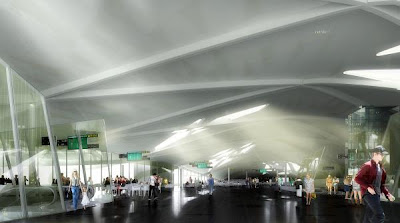Sunday, May 31, 2009
LBBW Immobilien - Headquarters - Stuttgart | LAVA





The LBBW headquarters is a forwardlooking component of the development of Stuttgart. The zero-energy office building combines high quality public domain life with a resource-optimised workplace.
The innovative office concept is based on the findings of the research project, Office 21 by the Fraunhofer Institute. The traditional, modular building block
differs in the proposal in favor of a centralized system. The building is divided both horizontally and vertically
and interconnected via an atrium - the central location and communications heart of the project.
The 41,000 square meter zero-energy office building is efficient in both its energy consumption and construction.
An adaptive façade system allows light control, shading and energy optimisation. The facade consists of circular discs with integrated photovoltaic elements. By moving these elements the appearance of the building changes during different times of day. The energy generating
facade moves seamlessly over the structure, articulated at the roof level as a sensuous fifth facade.
Client: LBBW Immobilien
Location: Pariser Platz, Stuttgart, GER
Status: Study
Area: 41.500 sqm
Consultants:
Structure: Werner Sobek Ingenieure,
Stuttgart, GER
Climate: Transsolar KlimaEngineering,
Stuttgart, GER
all picts: LAVA
Maritime Terminal,Tangier,Morocco | ODILE DECQ BENOIT+CORNETTE













Construction of the passenger terminal for the harbour station of Tangier. In association with Khalid Molato Architect 36000 M2.
Texts and images from:ODILE DECQ BENOIT+CORNETTE
Estonian National Museum Building Complex | Vincent Callebaut






























PROGRAM : International Architectural Competition for the Estonian National Museum Building Complex
LOCATION : The Raadi Manor Complex
SURFACE AREA : 40.000 M²
CLIENT : The Ministry of Culture of the Republic of Estonia, The Estonian National Museum and the Estonian Architects Association
PERSPECTIVES : Philippe Steels
“The ENM is an ethnologically (cultural anthropology) oriented national central museum, whose ethnological, cultural research and museology activities aid in the preservation and development of Estonian culture, keeping Estonian identity in an increasingly globalising world and fostering better understanding between different culture.”LOCATION : The Raadi Manor Complex
SURFACE AREA : 40.000 M²
CLIENT : The Ministry of Culture of the Republic of Estonia, The Estonian National Museum and the Estonian Architects Association
PERSPECTIVES : Philippe Steels
For the hundredth anniversary of the creation date of the Estonian National Museum in 2009, the Estonian Ministry of Culture in conjunction with the Estonian National Museum and the Union of Estonian Architects, would like to build a new building complex in Tartu, the second largest city in Estonia. The Raadi Manor Complex is located on the Eastern district of the city of Tartu along the rural municipality.
At the crossing of the Estonian and Finno-Ugric History and cultures, the Estonian national Museum (ENM) presents an architecture that inserts itself as a built geography. Towards a new understanding of the place, it imposes itself like an open field of multilayer strength that compresses the nature of the city and of the dynamic processes which govern it. It is an animated matrix with compressive folds topologically open which forms a common meeting frame between the city and the rural municipality, between the site and the visitor. The museum is at the intersection of new devices able, simultaneously, to generate reactive mechanisms (operating paradoxes) and evolutional spaces (landscapes). It is an interactive field of strengths among other fields, a geography of transition.
Texts and images from:Vincent Callebaut
Subscribe to:
Comments (Atom)
















